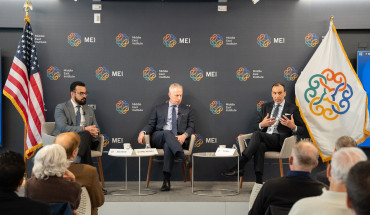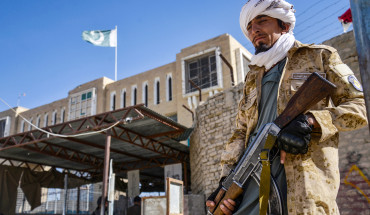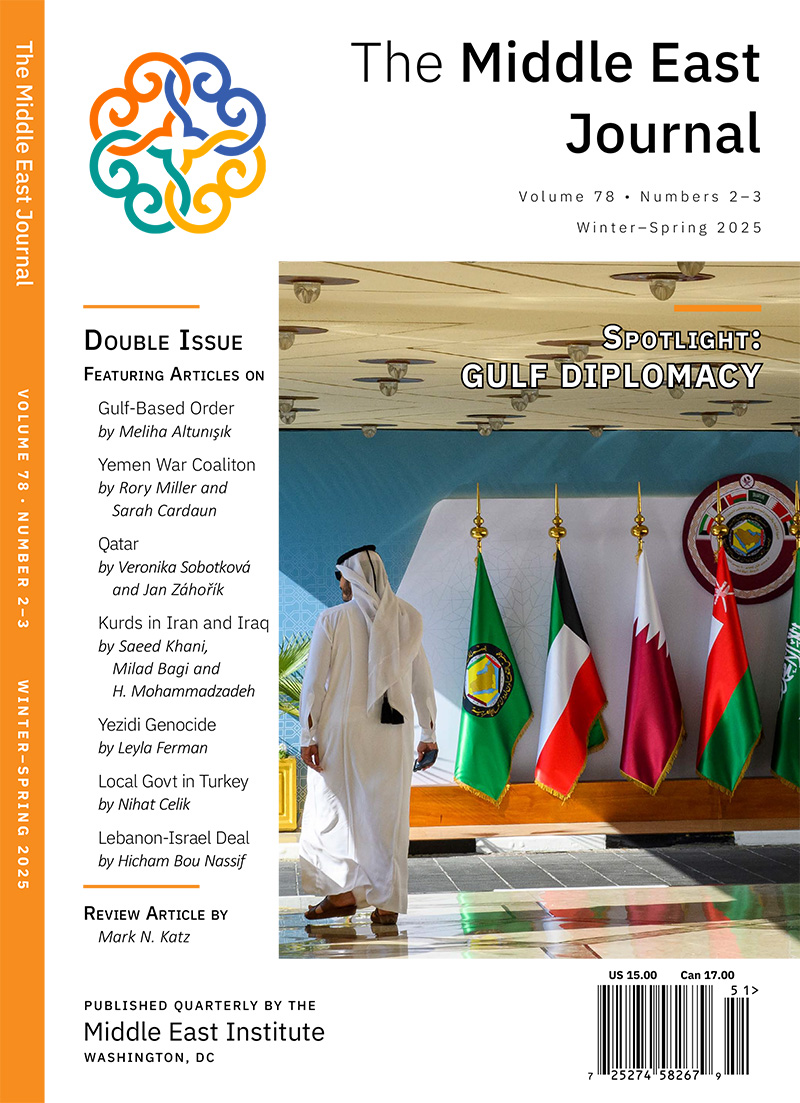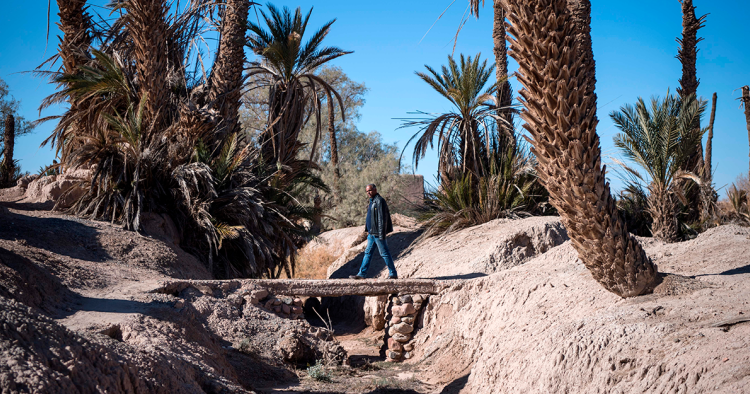This article is part of an MEI research initiative examining the complex interplay between food security, governance, political stability, and economic development in North Africa and the Sahel. The project brings together a diverse range of perspectives with grounded views of local realities and their global implications through a series of articles, policy papers, and a final report.
Climate variability is becoming a key factor in shaping economic stability, agricultural productivity, and water security worldwide. Periods of prolonged drought and sudden shifts in precipitation can have far-reaching consequences, particularly for countries that rely heavily on natural water sources for farming and economic growth. As weather patterns become increasingly unpredictable, there is a need to navigate both the immediate impacts of climate change and the long-term strategies required for climate resilience. Finding the right balance between short-term relief and sustainable adaptation is a fundamental challenge for economies dependent on agriculture and water availability.
Nowhere is this more evident than in Morocco, where a deluge of rainfall has exceeded the norm amid a period of sustained drought. The outlook for continued rainfall remains positive and will likely benefit the country in meeting the water demands of various sectors, especially agriculture. However, expectations should be tempered, as these short-term boosts in precipitation are unlikely to significantly alleviate Morocco’s ongoing drought conditions. This underscores the need for a more proactive and comprehensive approach to managing the effects of drought in the country.
Over the course of a month, beginning in late February 2025, Morocco experienced exceptionally heavy precipitation, the most significant since the start of a multi-year drought in 2018. During this period, Morocco recorded 43.5 millimeters (mm) of rainfall, a stark contrast to the 18 mm recorded for the same timeframe in the previous year. This was equivalent to more than 130% of the normal yearly average for the period, marking a significant departure from recent dry conditions.
This enhanced precipitation, which included rainfall as well as snowfall in higher elevation areas, resulted in notable increases in water inflow routing into storage dams across Morocco. However, as of March 27, the average volume for all major dams in the country stood at a modest 37.84% of total capacity. Although that rate has been steadily increasing since the onset of heavy rains, there is significant variation in dam filling regionally, with northern basins seeing rates in excess of 50%, while some basins in the south have achieved only 10-20% capacity.
This boost in precipitation comes as a welcome, though temporary, relief to Morocco, which has long been grappling with the effects of persistent drought and has been categorized by the World Resources Institute as under high water stress. Prior to the arrival of these rains, water levels in reservoirs were dangerously low, threatening the reliability and sustainability of water supplies. Morocco’s agricultural sector has been particularly hard-hit, with higher livestock mortality rates and severe declines in wheat yields.
The prolonged drought has taken a heavy toll on the agricultural sector, substantially affecting the country’s economic health. Although only one-fifth of Morocco’s farmland is irrigated, agriculture accounts for about one-sixth of its economy. As a result, the drought has contributed to a 7% decline in Morocco’s overall economic output. The economic outlook for 2025 appears to be more favorable, in small part due to the improved climate conditions that yielded the uptick in recent precipitation. With more rainfall and subsequent water storage in dams offering local agriculture a reprieve from the harsh effects of drought, Morocco’s agricultural GDP is expected to grow by 4.5% in 2025, while overall economic growth is projected to increase by 3.6%. While encouraging, these short-term and unevenly distributed gains from seasonal rainfall will not solve Morocco’s long-term water supply and distribution problems.
Much of the positive economic outlook for Morocco’s agricultural sector, absent policies to reduce reliance on rainfall and change consumption practices, will depend on the highly variable continuation of favorable climate conditions that amplify the likelihood of increased precipitation. Local climatologists anticipate that heavy rainfall could persist well into the spring season, with an accompanying potential shift in climate patterns from El Niño, a phenomenon with typically warmer temperatures and largely thought to be responsible for Morocco’s current drought, to the generally cooler and wetter La Niña pattern. The predicted onset of La Niña could create conditions conducive to generating extended periods of rainfall and alleviating water shortages but will not change the fact that Morocco is essentially a desert.
While the recent rainfall has had a positive impact on water storage reservoirs and provided much-needed relief to local agriculture, Morocco’s overall food security remains fragile. The continued loss of wheat yields due to the prolonged drought has led Morocco to extend its wheat import subsidy program through the end of the year. This move signals that the upcoming wheat harvest will likely fall short of domestic demand, thus requiring imports to bridge the gap.
Though the increase in rain may have provided a hydrological reprieve to drought, it is a temporary solution to Morocco’s ongoing water and agricultural challenges. The country’s reliance on rainfall for both agriculture and water storage underscores the vulnerability of its economy to climate fluctuations. Sustained recovery will depend not only on continued precipitation in the coming months, but also on long-term investments in water conservation, irrigation efficiency, and drought-resistant crops. Yet, these adaptations primarily focus on managing water use within the agricultural sector. Strengthening Morocco’s resilience to frequent and prolonged droughts also requires enlarging its water supply. Water augmentation strategies, such as expanding desalination, enhancing aquifer recharge, and increasing water recycling, can help meet growing demands and ensure long-term sustainability. Without these measures, future droughts could once again threaten agricultural productivity and economic stability.
Looking ahead, Morocco must balance short-term gains from increased rainfall with the need for long-term climate resilience. While the current projections for economic and agricultural growth are optimistic, they remain contingent on favorable climate and weather conditions. Morocco will need to implement adaptive strategies to mitigate the risks of future droughts and ensure food security for its population. A rational path to long-term agricultural and economic stability relies on sustained efforts in climate adaptation and water resource management. With comprehensive, forward-thinking policies, Morocco can secure a resilient future in the face of climate variability.
Mohammed Mahmoud is the CEO and founder of the Climate and Water Initiative as well as the lead for Middle East Climate and Water Policy at the United Nations University Institute for Water, Environment, and Health. He was previously the founding director of MEI's Climate and Water Program. His areas of expertise include climate change adaptation, water policy analysis, and scenario planning.
Photo by FADEL SENNA/AFP via Getty Images
The Middle East Institute (MEI) is an independent, non-partisan, non-for-profit, educational organization. It does not engage in advocacy and its scholars’ opinions are their own. MEI welcomes financial donations, but retains sole editorial control over its work and its publications reflect only the authors’ views. For a listing of MEI donors, please click here.













